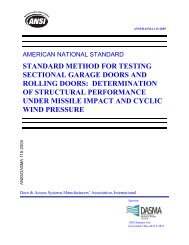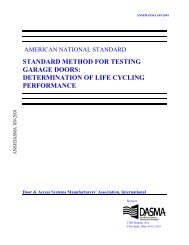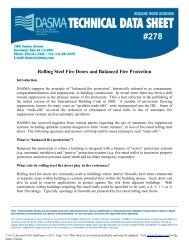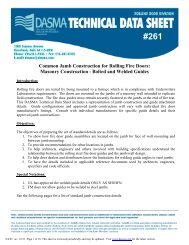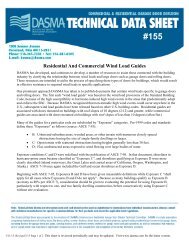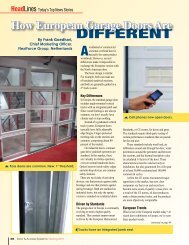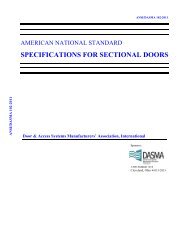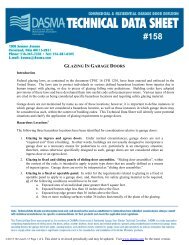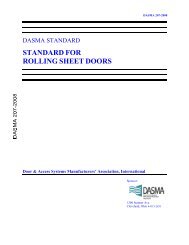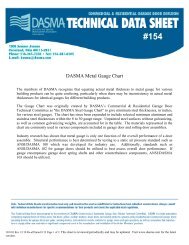Garage Door Manual Operation - Dasma.com
Garage Door Manual Operation - Dasma.com
Garage Door Manual Operation - Dasma.com
Create successful ePaper yourself
Turn your PDF publications into a flip-book with our unique Google optimized e-Paper software.
#165<br />
<strong>Garage</strong> <strong>Door</strong> <strong>Manual</strong> <strong>Operation</strong><br />
INTRODUCTION<br />
Handles or suitable gripping points are a practical and convenient way to operate a garage door manually. This<br />
Technical Data Sheet is intended to help clarify the need for occasional manual operation of an automated garage<br />
door including the use of handles/suitable gripping points for such operation.<br />
THE NEED FOR MANUAL OPERATION<br />
Common reasons for manually operating a normally automated garage door include:<br />
• Power outages. During a power outage, besides the continuation of the convenience of garage use, it may<br />
be<strong>com</strong>e necessary to open and/or close a garage door for safety or emergency reasons.<br />
• <strong>Garage</strong> door operator malfunctioning. In order for a homeowner or building owner to continue to move<br />
vehicles and other items into or out of a garage in the event of a garage door operator malfunction, the<br />
door would need to be operated manually until the operator is properly serviced. Note: DASMA<br />
re<strong>com</strong>mends that a trained door systems technician provide service for malfunctioning garage door<br />
operators.<br />
• Routine door maintenance. Published industry guidelines re<strong>com</strong>mend that homeowners and building<br />
owners perform periodic routine maintenance steps on the door itself, including disconnecting the<br />
operator to check the door’s balance and overall operation. See DASMA Technical Data Sheet #167 for a<br />
re<strong>com</strong>mended checklist to follow.<br />
Please note that the garage door operator manufacturer’s instructions should be carefully followed when<br />
disconnecting the operator from the door.<br />
2/17/05 Page 1 of 3 This sheet is reviewed periodically and may be updated. Visit www.dasma.<strong>com</strong> for the latest version.
#165<br />
FACTORS ASSOCIATED WITH MANUAL OPERATION<br />
Handles versus Suitable Gripping Points<br />
Over the years, many manually operated garage doors have included handles that typically protrude from the<br />
surfaces of garage door sections. As an alternative to handles, “suitable gripping points” are considered to be<br />
acceptable if the operator of the door can grip the garage door to apply sufficient force to manually open or close<br />
a door. These gripping points may either protrude, or be recessed, with respect to garage door section surfaces.<br />
Number, Location and Placement of Handles / Suitable Gripping Points<br />
A total of four handles or suitable gripping points are required to meet Section 7 of ANSI/DASMA 116, the<br />
voluntary industry standard governing garage door section interfaces. Two handles / suitable gripping points are<br />
to be located on the inside garage door surface, and two are to be located on the outside garage door surface. The<br />
standard describes that the placement of the handles or gripping devices shall be within 8 inches of the bottom<br />
edge of the bottom section, and on the second or third section, placed vertically in line with one another to allow<br />
manual operation of the door.<br />
Design of Handles / Suitable Gripping Points<br />
Manufacturers have the option to design/manufacture any configuration of handles or suitable gripping points,<br />
provided they are satisfied that users can effectively manually operate doors with such configurations.<br />
2/17/05 Page 3 of 3 This sheet is reviewed periodically and may be updated. Visit www.dasma.<strong>com</strong> for the latest version.



